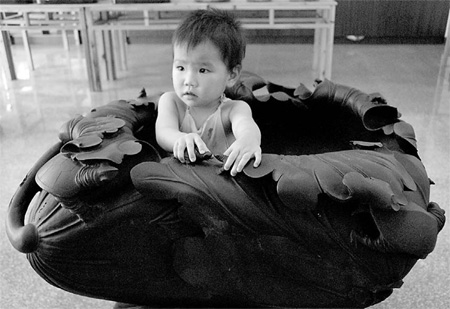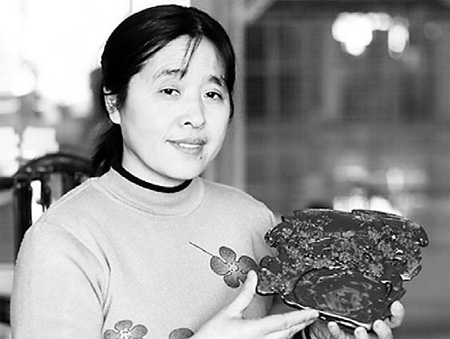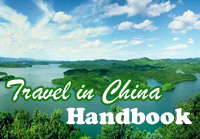Lofty Lushan Mountain
Temples in Hidden Places
On the First of August
Wheels by the Water
Share your travel story with regional@chinadaily.com.cn
Set in stone
By Zhao Ying ( China Daily )
Updated: 2011-12-12
 |
|
A girl sits in a large inkstone in Wuyuan, Jiangxi province. Inkstones are considered one of the traditional "four treasures of study" and have continued gaining popularity among collectors. Wang Guohong / for China Daily |
 |
|
Cheng Lijun shows an inkstone produced in Shexian county, Anhui province. Provided to China Daily |
Inkstones have remained a national obsession since ancient times and their future popularity appears rock solid. Zhao Ying from China Features reports.
Cheng Lijun quite literally loves her inkstones to death.
"I just want to be buried with my inkstones after I pass away," Cheng says, sitting in her tiny inkstone shop in southeast Beijing.
The 49-year-old native of Shexian county in East China's Anhui province has devoted much of her life to carving, collecting and selling "Sheyan" or "She inkstones" - small stone mortars for the grinding and containment of ink.
Celebrated as one of the "four famous inkstones" - Duan, Taohe and Chengni are the others - the She inkstone variety that's mostly produced in Shexian county is categorized by the various mines from which the stone was obtained historically. It has a black color with fine gold-like markings. She inkstones were first used during the Tang Dynasty (AD 618-907).
Cheng learned to carve inkstones in 1985 in order to make a living. Many others in her hometown also depend on inkstones to put food on the table and sell the raw stones needed to create inkstones.
For serious calligraphers and painters, the quality of the inkstone is just as important as the quality of the ink that is ground inside of it, as the inkstone can affect the ink's texture. Paper, ink, brushes and inkstones - otherwise known as the "four treasures of study" - are the primary tools used in Chinese calligraphy and painting.
Although their practical functions have diminished amid technological development, their artistic and cultural value has continued to attract artists and collectors, Cheng says.
"I'm not in the mood to eat or sleep when I get a new piece of perfectly raw stone. The only thing on my mind is how to carve it to show its beauty," Cheng says, gently touching an inkstone engraved with a delicate, twisting dragon.
However, Cheng had to give up carving in 2004 because of her increasingly severe cough. But she was determined to continue working with the stones and moved to Beijing to open a booth at the Panjiayuan antiques market, where she sells stones made in her hometown.
The price of the raw stone used to make She inkstones has increased significantly over the years due to shrinking stone reserves. Higher prices have stimulated mine exploration, which has led to even greater consumption, Cheng says.
Cheng gave up her plan to buy an apartment in Beijing three years ago and poured all of her money into purchasing high-end raw stone.
"The business was initially a way of feeding the family, but now it is more like a form of spiritual support for me," Cheng says.
She lives with her husband and 12-year-old son in a two-bedroom apartment near Panjiayuan. Her housing costs of 2,600 yuan ($408) a month and is her largest expense. Cheng has adopted an austere lifestyle - no cosmetics, no fancy meals and no new dresses.
"I care about and own nothing but (She) inkstones," she says.
"I have no desire for luxuries at all, but I feel calm and safe while gazing at or touching the stones."
Cheng once turned down a young buyer to sell an expensive She inkstone to an old professor who paid less. She also persuaded a customer to give up one of three high-end inkstones so that others could have a chance to buy it.
"Every inkstone is a masterpiece of nature and craftsmanship, so I'm always looking forward to buyers who really understand and cherish the stones," she says.
"I just hope to match as many inkstones with sincere collectors as possible."
Veteran collector Chen Guoyuan points out the "four treasures of study" have recorded and carried forward Chinese civilization, promoted Chinese art to the world and brought fame to numerous artists and their valuable masterpieces.
Moreover, the 72-year-old says the four "treasures" have served the political, economic and cultural fields that have contributed to China's social evolution.
"No artwork can match their significant role," says Chen, who has collected more than 400 kinds of inkstones over the past 26 years.
Inkstones were popular among ancient China's royal families.
The State leaders of modern China, including former leader Deng Xiaoping and President Hu Jintao, are fond of inkstones, too.
In 1978, Deng gave then Japanese prime minister Takeo Fukuda a Duan inkstone. And 30 years later, Hu presented a Duan inkstone as a gift to Takeo's son Yasuo Fukuda, during his "warm spring" visit to Japan.
Chen, a former Chinese Air Force political officer, named his own home after a particular Duan inkstone produced in Zhaoqing, Guangdong province. He said he first saw the stone in 1990 while attending an exhibition and hunted for it for years afterward.
Tortured by not owning the inkstone, Chen finally bought it in 1994 for 50,000 yuan ($5,911), which put him 20,000 yuan in debt. His monthly salary was then 500 yuan.
People thought he was crazy, but time has proven the stone's value.
An auctioneer told Chen in 2009 that the value of the inkstone could hit 3 million yuan because of its rare composition and top-quality carving.
Many stones have indeed fetched high auction house prices. The 2009 Xiling Autumn Auction in the city of Zhejiang province's capital Hangzhou saw 95 inkstones auctioned at more than 14 million yuan in total.




